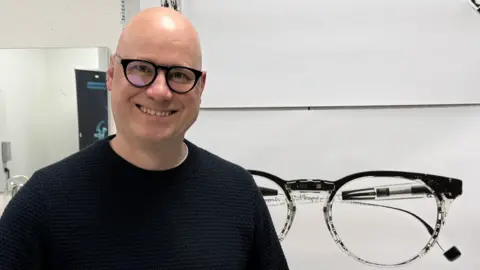In a groundbreaking development in the world of eyewear technology, Finnish company IXI has introduced an innovative product known as “autofocus” spectacles. These glasses, which bear a striking resemblance to conventional eyewear, are imbued with high-tech features designed to adapt to the wearer’s vision needs seamlessly. Niko Eiden, the CEO and co-founder of IXI, elaborated on the technology during a video call, showcasing lenses made with liquid crystals. This unique property allows the lenses to adjust their vision-correcting capabilities in real-time based on the wearer’s immediate requirements.
The essence of these autofocus spectacles lies in their ability to cater to individuals who typically require different glasses for various visual tasks, such as reading or seeing objects in the distance. Eiden explained that by applying an electrical field, these liquid crystals can change their orientation, ultimately modifying how light passes through the lenses. The glasses also incorporate an eye-tracking mechanism that enables the lenses to provide optimal correction instantaneously, tailored to the user’s current focus.
While the technology behind these spectacles is promising, Eiden is aware of the challenges that technologically advanced eyewear has faced in the past. A prominent example is Google Glass, which struggled with consumer acceptance due to its unconventional appearance. Eiden acknowledges this concern, emphasizing the need for their product to maintain the aesthetic of regular glasses rather than resembling cyborg-like devices, which most consumers would shy away from.
The relevance of this technology grows in light of the increasing global incidence of vision impairments such as presbyopia, which affects the ability to focus on close objects, and myopia, short-sightedness. With the aging world population, the demand for innovative eyewear is projected to escalate. Traditional spectacles, including bifocal and varifocal lenses, have maintained a somewhat static design for decades, often requiring users to shift their line of sight to different lens sections. In contrast, autofocus lenses have the advantage of dynamically adjusting to provide the necessary focus without the need for physical adjustments from the wearer.
Despite some challenges during initial product development—the first prototypes of these lenses were criticized for poor edge quality—recent tests have shown great promise. Test subjects in trial settings were asked to read text and subsequently shift their gaze to farther objects. They found that the glasses transitioned smoothly, fulfilling the performance expectations.
However, the technology does have limitations, especially in high-stakes environments. Medical professionals such as Paramdeep Bilkhu, a clinical adviser at the College of Optometrists, have raised concerns about relying on these autofocus lenses for safety-sensitive tasks like driving or surgical procedures. They question the reliability of the eye-tracking system in critical scenarios where precision is paramount. Eiden reassured that the first iteration of the glasses would not wholly adjust the entire lens area, allowing users to glance beyond the dynamically focused zone.
Interestingly, the development of this technology is paralleled by advancements made by other firms in the industry. For instance, Adlens, a UK company, previously offered manually adjustable glasses that altered lens curvature through a dial but ultimately faced challenges in market acceptance among opticians. Meanwhile, Prof. Chi-Ho To of the Hong Kong Polytechnic University has worked on lenses that aim to slow the progression of myopia in children through a unique honeycomb-like design.
In essence, while autofocus glasses like those from IXI hold significant potential, the industry still grapples with convincing consumers of their practicality and reliability. The future of such eyewear could see enhancements aimed not only at vision correction but also at reversing conditions such as myopia and offering a new dimension to personalized vision care. As IXI hones its product ready for market launch, the anticipation is palpable, coupled with an eagerness among professionals to observe how this class of eyewear will be embraced by the public.











